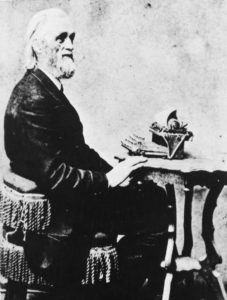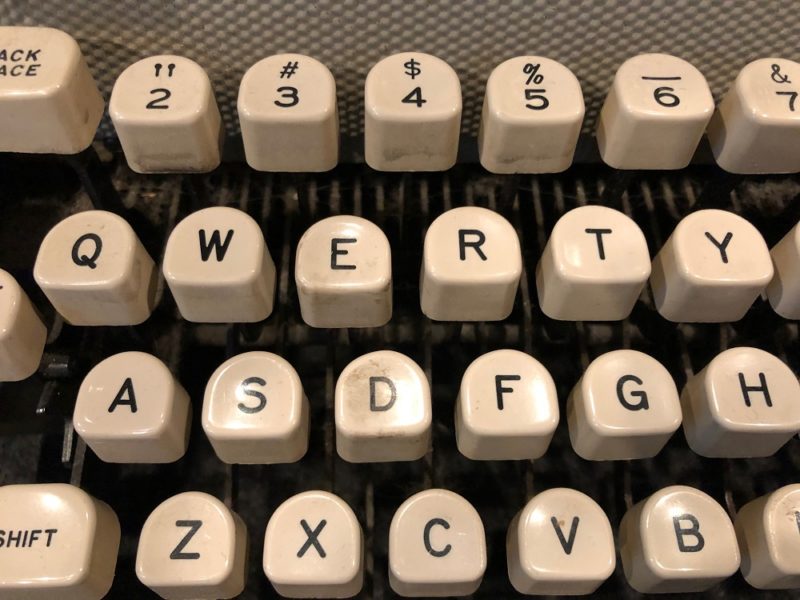If you’re near a computer keyboard, take a look at the first six letters on the upper row and you’ll find: Q-W-E-R-T-Y…or…qwerty. So who decided how the letters on our keyboards are arranged, and why that particular configuration? Writer Meg Jones tells the story of Christopher Latham Sholes, a Wisconsin politician and inventor who is considered by many, the “Father of the modern Typewriter.”
==
Who ever would have thought that some day people would type out their thoughts on a keyboard the size of an unbroken Graham cracker, using just their thumbs instead of all 10 fingers?
Certainly not Christopher Latham Sholes.
But in a way, it’s thanks to Sholes that we can so quickly tap messages on laptops and cell phones. The Milwaukee politician and newspaper publisher is credited as the father of the modern English typewriter keyboard. You know – the one with QWERTY on the top row.
Shortly after the Civil War, Sholes tried to invent a device for numbering book pages and patented his numbering machine. When Sholes and a business partner showed the machine to an amateur inventor at a machine shop located in what’s now a parking lot across from the Milwaukee Journal Sentinel building, the inventor suggested it be used for letters instead of numbers.
That was one of many “aha” moments for Sholes.
Still, it would take awhile before the keyboard, as we know it, would become standard. The Milwaukee Public Museum has one of the best typewriter collections in the world and it includes one of the first typing machines Sholes invented. It looks like a miniature piano with white and black wooden keys.

Portrait of Christopher Latham Sholes posing at a typewriter. (Courtesy of Wisconsin Historical Society)
Sholes was by no means the first to invent a literary piano. Many others had created typing machines but it is Sholes’ keyboard that is still here, still hard at work.
Ever wonder why letters are located where they are? Why are the “a” and “p” hit with your pinkies? Why is the space bar hit by your thumb? Why are letters that commonly go together like “s” and “t” or “t” and “h” not right next to each other?
It was all designed to slow fingers down. Back in the dark ages – and I’m talking even before the Blackberry – manual typewriter keys often jammed. Pinkies are not as strong as index fingers and typists often had to push harder with their weakest fingers while tapping out “a”s and punctuation.
After much trial and error Sholes patented his keyboard in 1873. However, it wasn’t exactly what keyboards look like today. It didn’t have a 1 or 0 because a lower case L and O could be used. And there was no exclamation point either. That was created with three key strokes – an apostrophe, back space and period.
Sholes was an interesting guy. In addition to creating the modern typewriter keyboard, he also served in the Wisconsin Legislature, was editor of the Milwaukee Sentinel, was named customs collector in the port of Milwaukee by President Abraham Lincoln and helped abolish the death penalty.
Only one person has ever been executed by the state of Wisconsin. The reason why it was just one criminal is due in no small part to Sholes.
Sholes was the publisher of the Kenosha Telegraph newspaper in 1851 when an Irish immigrant named John McCaffary was convicted of drowning his wife in a cistern. A crowd of at least 2,000 came to see McCaffary hanged. But the execution was botched and McCaffary slowly strangled for at least 20 minutes.
In an editorial in the Kenosha newspaper, Sholes called McCaffary’s death dreadful and called on the Legislature to abolish capital punishment. Which it did a short time later.
Sholes never earned much from his typewriter patents – he ended up selling his share to the Remington Company for $12,000. But his invention changed the world. Millions of typewriters with Sholes’ keyboard were manufactured and used to harness words flowing from their users’ brains, from Ernest Hemingway’s novels and World War II correspondents’ front-line dispatches to love notes, receipts and Dear John letters.









